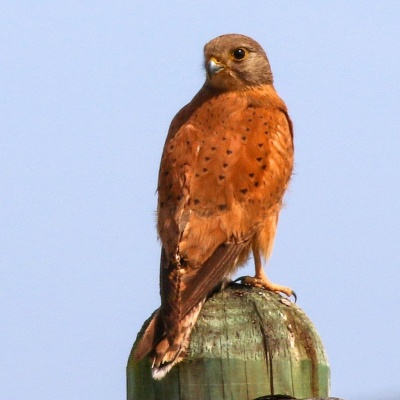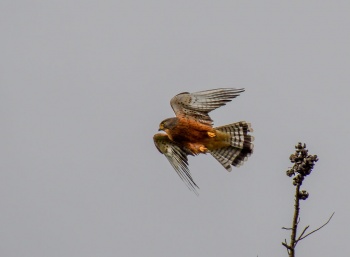(→Behaviour: Added actions, breeding, voice, movements and expanded diet.) |
(→Habitat: Amended.) |
||
| Line 12: | Line 12: | ||
It was formerly included in [[Common Kestrel]]. | It was formerly included in [[Common Kestrel]]. | ||
==Habitat== | ==Habitat== | ||
| − | + | Wide variety of habitats including fynbos, desert and cliffs; usually close to rocky outcrops. | |
| + | |||
==Behaviour== | ==Behaviour== | ||
====Actions==== | ====Actions==== | ||
Revision as of 09:37, 10 July 2018
- Falco rupicolus
Identification
27–35 cm (10½-13¾ in)
- Greyish head and tail
- Chestnut upperparts
Distribution
Africa: from northern Angola to Democratic Republic of the Congo, southern Tanzania and South Africa.
Taxonomy
This is a monotypic species.
It was formerly included in Common Kestrel.
Habitat
Wide variety of habitats including fynbos, desert and cliffs; usually close to rocky outcrops.
Behaviour
Actions
Forages by hovering over open country, pouncing on prey on the ground. Also hunts from a perch.
Diet
Their diet consists mostly of small mammals, birds, reptiles and insects.
Breeding
Monogamous. Nest is usually a scrape on cliff ledge but sometimes uses crow's nests or man-made structures where natural sites are unavailable.
Vocalisation
Metallic high-pitched kik-kik-kik. Also kreee-kreee notes.
Movements
Generally sedentary with local movements.
References
- Clements, J. F., T. S. Schulenberg, M. J. Iliff, D. Roberson, T. A. Fredericks, B. L. Sullivan, and C. L. Wood. 2017. The eBird/Clements checklist of birds of the world: v2017, with updates to August 2017. Downloaded from http://www.birds.cornell.edu/clementschecklist/download/
- Gill, F and D Donsker (Eds). 2015. IOC World Bird Names (version 5.3). Available at http://www.worldbirdnames.org/.
- Hockey, PAR, WRJ Dean, and PG Ryan, eds. 2005. Roberts' Birds of Southern Africa. 7th ed. Cape Town: John Voelcker Bird Book Fund. ISBN 978-0620340533
- Orta, J., Boesman, P. & Marks, J.S. (2018). Common Kestrel (Falco tinnunculus). In: del Hoyo, J., Elliott, A., Sargatal, J., Christie, D.A. & de Juana, E. (eds.). Handbook of the Birds of the World Alive. Lynx Edicions, Barcelona. (retrieved from https://www.hbw.com/node/53213 on 8 July 2018).
- BF Member observations
Recommended Citation
- BirdForum Opus contributors. (2024) Rock Kestrel. In: BirdForum, the forum for wild birds and birding. Retrieved 26 April 2024 from https://www.birdforum.net/opus/Rock_Kestrel
External Links





